
Echinocereus triglochidiatus Photo by: Andrea B.
The glorious flower colour of the ''Hedgehog Cactus'' rivals that of the desert sunset. The flowers are a beautiful deep red, with many petals that form the shape of a cup. They bloom from April through June, and are the first to bloom in the desert.
Origin and Habitat: E. triglochidiatus is the most widespread species (Nevada, Utah, and Colorado south to southern California, Arizona, New Mexico, Texas, and Mexico).
Altitude range: It can grow in elevations from 150 to 3500 metres above sea level.
Habitat: It is a resident of many varied habitats in the upper edge of the Mojave Desert, from low desert to rocky slopes, xerophyllous scrub, pine-oak forests, coniferous forests, rocky or grassy hillsides, ledges, and canyons mostly igneous and sometimes calcareous rock outcrops and cliffs in loamy-sandy soil, in humus pockets and in red loam soil. It is most abundant in shady areas. These plants can grow in colder climates because the stems clump so closely together. This reduces surface area through which it can lose heat. The species is pollinated by hummingbirds and probably bees. Echinocereus triglochidiatusSN|10576]]SN|10576]] has a very wide range, is abundant, and there are no major threats.
Synonyms:
See all synonyms of Echinocereus triglochidiatus
Common Names include:
ENGLISH: Mound Hedgehog-Cactus, Claret-Cup Hedgehog, Kingcup Cactus, King's Crown Cactus, Spineless Hedgehog, Strawberry Cactus, Mound Cactus, Crimson Hedgehog, Mound Hedgehog Cactus, Mojave Mound Cactus, Mojave Kingcup Cactus, Mojave Hedgehog, Curve-Spined Claret Cup, Claretcup Hedgehog
SPANISH (Español): Órgano-pequeño, Copa de Vino, Pitallito
TARAHUMARA: Híkuri, Wichurí
Description: In general it is a mounding cactus, forming bulbous piles of from a few to hundreds of spherical to cylindrical stems. Plants may vary from densely spiny (usually) to no spines at all. Echinocereus triglochidiatusSN|7140]]SN|10576]] is the most wide-spread of the Echiniocereus species and is also the most variable in appearance. In fact, the several varieties are so different-looking that the only uniting factor is the bright red bloom and rounded petals.
Taxonomy: A distinct species with two subspecies, the nominate form and subsp. mojavensis (Engelm. & J.M.Bigelow) L.D.Benson.
Stems: Usually erect, spherical or cylindrical, 3-70 cm tall, 5-13 cm in diameter.
Ribs: 5-8 or 8-12, crests slightly undulate (some populations contain plants with strongly interrupted ribs).
Areoles: 10-40 mm apart, and somewhat woolly.
Spines (0-)3-11 per areole, with central spines being difficult to distinguish from the radial spines. Straight to curved or contorted, appressed (radial spines) or spreading to projecting outward (some radials, and central spines when present), white to yellow, grey, or sometimes nearly black, but those turn whitish-grey after their first season.
Radial spines: (0-)1-10 per areole, (0-)15-90 mm long; Spines are at first yellow, pink or black.
Central spines: 0-1(-4) per areole, angular, (0-)50-120 mm long.
Flowers: Diurnal, funnel-shaped, 5-10 × 3-7 cm; flower tube 20-35 mm; flower tube hairs 1-2 mm; inner tepals bright orange-red to dark red, proximally paler (bases sometimes yellow or white), 25-40 × 10-15 mm, tips thick and rigid; anthers usually pink to purple. There is a thick nectar chamber and many thready pink stamens at the center of the corolla. The flowers are pollinated by hummingbirds.
Fruits: Juicy, with deciduous spines, and edible, green to yellow-green or pink (rarely red), (15-)20-35 mm, pulp white, fruiting 2-2.5 months after flowering.
Blooming season: Apr-June, the flowers remain open for 2 or 3 days. Blooming generally begins 5 to 10 years after sowing, as the plant matures.
Remarks: A spineless form (var. inermis) has been applied at various taxonomic ranks to individual plants with spines absent or nearly so in the eastern portion of var. mojavensis, mainly found in the mountains and mesas of western Colorado and eastern Utah. On these plants, areoles may have very few spines and some stems can be almost completely spineless, but the same plant will have spined stems and many spines per areole in another area.
Chromosome number: E. triglochidiatus is consistently diploid (2n = 22), apart from the tetraploid (2n = 44) Echinocereus coccineusSN|10576]]SN|7140]] Engelm., which has been treated as conspecific by some previous authors (Benson, 1982; Taylor, 1985). The var. triglochidiatus has been previously reported as var. gonacanthus (Engelm. & Bigelow) Boissevain and perhaps under other names as well.
Subspecies, varieties, forms and cultivars of plants belonging to the Echinocereus triglochidiatus group
Notes: Echinocereus triglochidiatusSN|8495]]SN|10576]] is the earliest name for a large group of diploid and polyploid taxa treated as conspecific by L. D. Benson (1969, 1982). The tetraploids are now recognized as a distinct species: E. coccineus, including E. polyacanthus Engelmann of Mexico. A geographically distant tetraploid, Echinocereus coccineus var. paucispinusSN|10576]]SN|8495]], superficially resembles some eastern E. triglochidiatus but may be distinguished by its relatively terete and more consistently straight spines.
Bibliography: Major references and further lectures
1) David Hunt, Nigel Taylor “The New Cactus Lexicon” DH Books, 2006
2) Edward F. Anderson “The Cactus Family” Timber Press, 2001
3) Terry, M., Heil, K., Gómez-Hinostrosa, C. & Corral-Díaz, R. 2013. Echinocereus coccineus. The IUCN Red List of Threatened Species. Version 2014.3. <www.iucnredlist.org>. Downloaded on 29 April 2015.
4) Stuart Max Walters “The European Garden Flora: Dicotyledons (Part I)” Cambridge University Press, 1989
5) Terry, M., Heil, K. & Corral-Díaz, R. 2013. Echinocereus triglochidiatus. The IUCN Red List of Threatened Species 2013: e.T152410A633801. http://dx.doi.org/10.2305/IUCN.UK.2013-1.RLTS.T152410A633801.en . Downloaded on 15 November 2015.
6) Taylor, N. P. "The genus Echinocereus." Timber Press, Portland, Oregon, USA.1985.
7) Benson, L. "The cacti of the United States and Canada." Stanford University Press, Stanford, California, USA. 1982.
8) Blum, W., M. Lange, R. Werner, and J. Rutow. "Echinocereus, Monographie." Im Grüntal 19, D-52066, Aachen, Germany. 1998.
9) Ferguson, D. J. "Revision of the U.S. members of the Echinocereus triglochidiatus group." Cactus and Succulent Journal (U.S.) 61: 217–224. 1989.
10) A. Michael Powell, and James F. Weedin "Chromosome numbers in Chihuahuan Desert Cactaceae. III. Trans-Pecos Texas" Am. J. Bot. March 2001 vol. 88 no. 3 481-485
11) Grant, K. A. "A hypothesis concerning the prevalence of red coloration in
California hummingbird flowers." American Naturalist 100:85-98. 1966.
12) Grant, K. A., and V. Grant. "Hummingbirds and their flowers." Columbia University Press, New York, USA. 1968.
13) James H. Brown and Astrid Kodric-Brown "Convergence, Competition, and Mimicry in a Temperate Community of Hummingbird-Pollinated Flowers" Ecology, Vol. 60, No. 5 (Oct., 1979), pp. 1022-1035
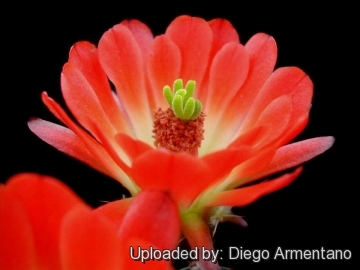 Echinocereus triglochidiatus Photo by: Diego Armentano
Echinocereus triglochidiatus Photo by: Diego Armentano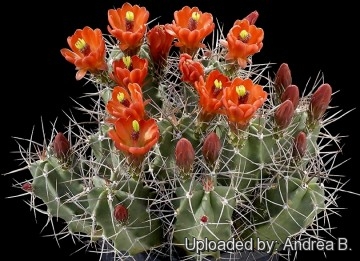 - It is a beautiful plant with long-lasting, waxy, scarlet flowers, which make it a favorite among gardeners.The flowers are pollinated by hummingbirds. Photo by: Andrea B.
- It is a beautiful plant with long-lasting, waxy, scarlet flowers, which make it a favorite among gardeners.The flowers are pollinated by hummingbirds. Photo by: Andrea B.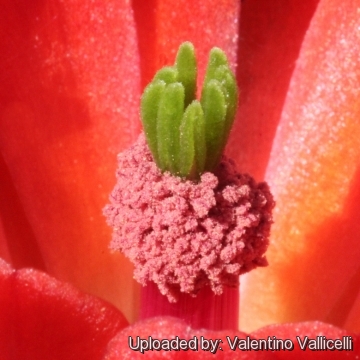 Echinocereus triglochidiatus Photo by: Valentino Vallicelli
Echinocereus triglochidiatus Photo by: Valentino Vallicelli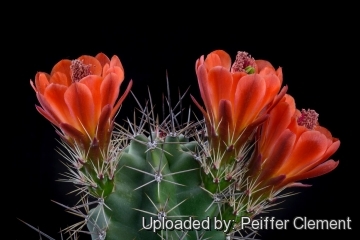 Echinocereus triglochidiatus Photo by: Peiffer Clement
Echinocereus triglochidiatus Photo by: Peiffer Clement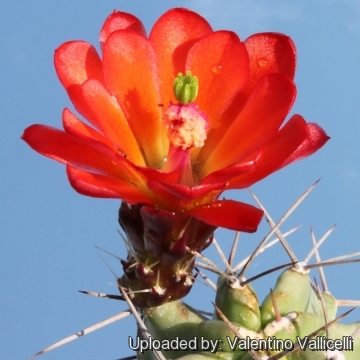 Echinocereus triglochidiatus Photo by: Valentino Vallicelli
Echinocereus triglochidiatus Photo by: Valentino Vallicelli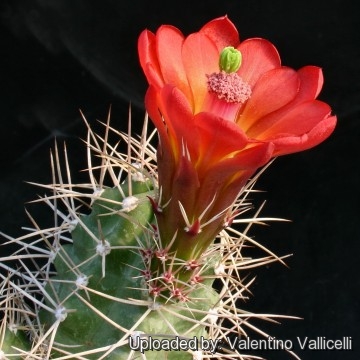 Echinocereus triglochidiatus Photo by: Valentino Vallicelli
Echinocereus triglochidiatus Photo by: Valentino Vallicelli Echinocereus triglochidiatus Photo by: Valentino Vallicelli
Echinocereus triglochidiatus Photo by: Valentino Vallicelli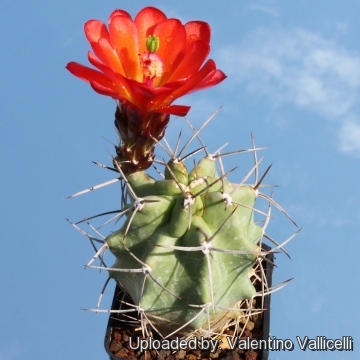 Echinocereus triglochidiatus Photo by: Valentino Vallicelli
Echinocereus triglochidiatus Photo by: Valentino VallicelliCultivation and Propagation: Cultivation: This cactus is widely cultivated for its flowers. It is among the easiest species to grow, flower and propagate. Water regularly from March to October. Rot prone in winter, it needs good drainage. Claret Cups require strong sunlight to maintain a healthy appearance, and a harsh "dry and cool" winter environment combined with maximum light exposure enhances spring flower production.
Frost Tolerance: Depends on the variety: Var. arizonicus is hardy to -6° C, the other varieties are much more cold resistant (some populations can tolerate temperatures down to -25° C or less)
Uses: Some Native Americans collect the stems, burn off the spines and mash them. Sugar is added and then it is baked to make sweet cakes.
Parts Used: pulp, flowers and stems
Your Photos

by Valentino Vallicelli

by Valentino Vallicelli

by Cactus Art





















